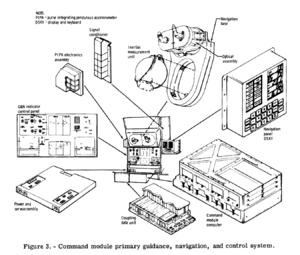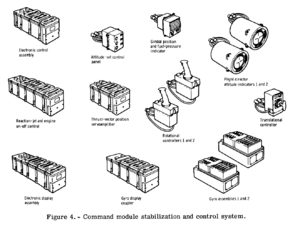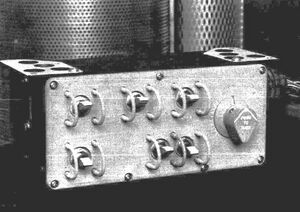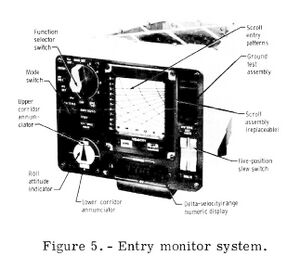Guidance and Control System: Difference between revisions
imported>Mark Grant m (→External Links) |
imported>Mark Grant (→Orbital Rate Display Earth And Lunar: - basic overview.) |
||
| Line 24: | Line 24: | ||
{{mainarticle|Orbital Rate Display Earth And Lunar}} | {{mainarticle|Orbital Rate Display Earth And Lunar}} | ||
In normal use the [[Flight Director Attitude Indicator (CSM)| Flight Director Attitude Indicator]] displays would show the inertial attitude relative to distant stars. This was useful in free space, but when in orbit the pilot may want to see the spacecraft's attitude relative to the surface of the Earth or Moon. | |||
The Orbital Rate Display Earth And Lunar (ORDEAL) was a simple system which could be configured to rotate the FDAIs appropriately so that they would display the attitude relative to the surface instead. | |||
<br clear="right"> | <br clear="right"> | ||
Revision as of 03:08, 30 November 2006

The Guidance and Control System consisted of a number of sub-systems for in-flight navigation and guidance.
This article gives a high-level overview of the sub-systems: detailed information use will be on individual pages for those systems.

Stabilisation and Control System (SCS)

|{{#if:|, | and }}[[{{{2}}}|{{{2}}}]]}}{{#if:
|{{#if:|, |, and }}[[{{{3}}}|{{{3}}}]]}}{{#if:
|{{#if:|, |, and }}[[{{{4}}}|{{{4}}}]]}}{{#if:
|, and [[{{{5}}}|{{{5}}}]]}}{{#if: | (too many parameters in {{mainarticle}})}}
Orbital Rate Display Earth And Lunar

|{{#if:|, | and }}[[{{{2}}}|{{{2}}}]]}}{{#if:
|{{#if:|, |, and }}[[{{{3}}}|{{{3}}}]]}}{{#if:
|{{#if:|, |, and }}[[{{{4}}}|{{{4}}}]]}}{{#if:
|, and [[{{{5}}}|{{{5}}}]]}}{{#if: | (too many parameters in {{mainarticle}})}}
In normal use the Flight Director Attitude Indicator displays would show the inertial attitude relative to distant stars. This was useful in free space, but when in orbit the pilot may want to see the spacecraft's attitude relative to the surface of the Earth or Moon.
The Orbital Rate Display Earth And Lunar (ORDEAL) was a simple system which could be configured to rotate the FDAIs appropriately so that they would display the attitude relative to the surface instead.
Entry Monitoring System

|{{#if:|, | and }}[[{{{2}}}|{{{2}}}]]}}{{#if:
|{{#if:|, |, and }}[[{{{3}}}|{{{3}}}]]}}{{#if:
|{{#if:|, |, and }}[[{{{4}}}|{{{4}}}]]}}{{#if:
|, and [[{{{5}}}|{{{5}}}]]}}{{#if: | (too many parameters in {{mainarticle}})}}
The Entry Monitoring System is used by the crew to monitor the entry trajectory flown by the PGNCS and allows the pilot to fly a manual re-entry if required.
The main EMS panel includes a velocity/load-factor display, range-to-go display, 0.05g indicator and roll/attitude indicator.
External Links
- Apollo experience report: Command and service module reaction control systems
- Apollo experience report: Guidance and control systems
- Apollo experience report: Guidance and control systems - Digital autopilot design development
- Apollo experience report: Lunar module landing radar and rendezvous radar
- Apollo experience report: Lunar module reaction control system
- Apollo Training: Guidance and Control Systems